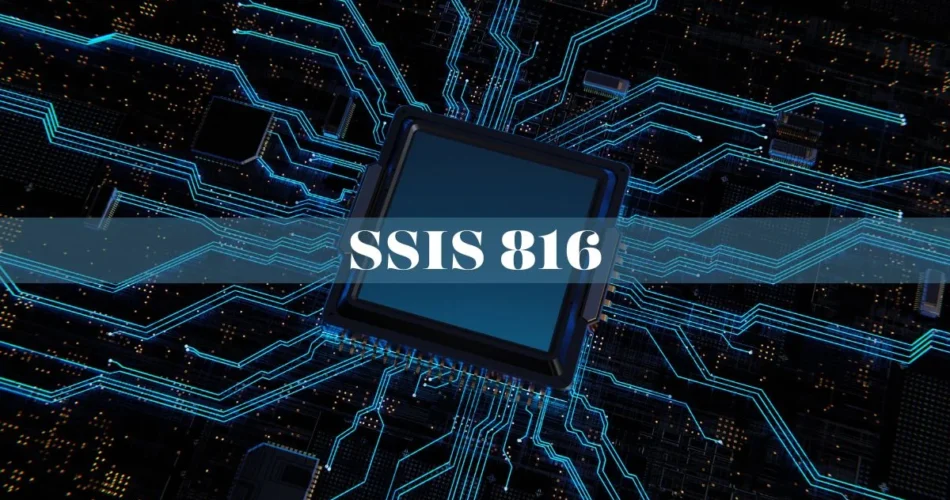Are you ready to take your data integration to the next level? Look no further than SSIS 816! This powerful tool is packed with new features and enhancements that can supercharge your ETL processes. In this blog post, we will dive into the world of SSIS 816, exploring its significance, key features, real-world applications, and more. Get ready to unlock the full potential of SSIS 816 and revolutionize how you handle data integration tasks!
Table of Contents
Introduction to SSIS 816
Are you ready to unlock the power of SSIS-816? SQL Server Integration Services (SSIS) has evolved with exciting new features and enhancements in version 816. This robust data integration tool offers advanced capabilities to streamline your ETL processes and optimize data workflows.
SSIS-816 introduces cutting-edge functionalities that empower users to extract, transform, and load data more efficiently than ever before. With enhanced performance and scalability, this latest version enables organizations to handle large volumes of data with ease.
Whether you are a seasoned SSIS user or exploring its potential for the first time, SSIS 816 provides a user-friendly interface and comprehensive tools to meet your data integration needs. Stay tuned as we delve deeper into the key features and benefits of SSIS-816 in this blog series.
The Significance and Evolution of SSIS 816
SSIS 816, short for SQL Server Integration Services version 816, marks a significant milestone in the evolution of data integration tools. With each iteration, SSIS continues to enhance its capabilities to meet the growing demands of modern data management.
The significance of SSIS-816 lies in its ability to streamline complex ETL processes, enabling organizations to efficiently extract, transform, and load data from various sources. This results in improved data quality and faster decision-making.
Evolution-wise, SSIS-816 introduces advanced features such as enhanced connectivity options, improved performance optimizations, and better error handling mechanisms. These enhancements empower users to tackle diverse data integration challenges with ease and precision.
As technology advances at a rapid pace, SSIS-816 evolves along with it by incorporating cutting-edge functionalities that cater to the ever-changing landscape of Big Data and analytics.
Key Features and Enhancements in SSIS 816
When diving into the key features and enhancements of SSIS 816, it’s essential to highlight the advancements that bring added value to data integration processes. One notable feature is the improved scalability, allowing for seamless handling of large datasets with enhanced performance.
Enhanced connectivity options make it easier to integrate data from various sources, including cloud platforms and databases. The updated control flow tasks provide more flexibility in designing complex workflows, streamlining the development process.
The introduction of new task components simplifies common data transformations and manipulations. Additionally, enhanced debugging capabilities help identify and troubleshoot issues efficiently during package execution.
Improved security features ensure that sensitive data is protected throughout the integration process. These key features elevate the functionality of SSIS-816, making it a powerful tool for efficient data management and processing.
Real-World Applications and Business Benefits of SSIS-816
When it comes to real-world applications, SSIS-816 offers cutting-edge solutions for data integration tasks. Businesses can streamline their processes by efficiently moving and transforming data from various sources with ease. This means faster decision-making based on up-to-date information.
One key benefit of SSIS-816 is its ability to handle complex ETL (Extract, Transform, Load) processes seamlessly. It empowers organizations to extract valuable insights from their data quickly and accurately. Additionally, the enhanced performance optimization in SSIS-816 leads to improved efficiency and cost savings.
With features like advanced logging and monitoring capabilities, businesses can ensure the integrity and security of their data throughout the integration process. Moreover, the flexibility to work with both on-premises and cloud-based systems opens up new possibilities for scalability and growth.
Adopting SSIS-816 can revolutionize how businesses manage their data workflows, leading to increased productivity and competitiveness in today’s digital landscape.
Upgrading to SSIS-816: How to Optimize Performance
Are you considering upgrading to SSIS-816? Optimizing performance is key. To start, evaluate your current system and identify bottlenecks that could be improved by the new features of SSIS-816. Plan your upgrade carefully to ensure a smooth transition without disruptions.
Before diving into the upgrade process, make sure to back up all essential data to prevent any potential loss during the migration. Testing is crucial; run performance tests before and after the upgrade to measure improvements accurately.
Utilize the enhanced monitoring capabilities in SSIS-816 to keep track of data flow and identify any issues promptly. Take advantage of parallel processing options for faster execution of tasks within your packages.
By optimizing performance through a well-planned upgrade, you can harness the full potential of SSIS-816 for your data integration needs.
Future Trends and Outlook for SSIS-816
As technology continues to advance, the future trends for SSIS 816 look promising. Integration Services is expected to become even more efficient and user-friendly, catering to the evolving needs of businesses worldwide. With a focus on automation and scalability, SSIS-816 is poised to streamline data integration processes across various platforms seamlessly.
One key trend on the horizon is increased support for cloud-based solutions within SSIS-816. This shift towards cloud integration will enable organizations to leverage the power of cloud computing while enhancing data management capabilities. Additionally, we can anticipate further enhancements in performance optimization tools and real-time data processing features within SSIS-816.
Moreover, as big data analytics continue to shape industries globally, SSIS-816 is likely to incorporate advanced analytics functionalities for better decision-making insights. The future outlook for SSIS-816 suggests a continued commitment towards innovation and adaptability in an ever-changing technological landscape.
Conclusion
SSIS 816 is a powerful tool that offers advanced features and enhancements to streamline data integration processes. By leveraging these new capabilities, businesses can improve efficiency, maximize performance, and drive better decision-making. As technology continues to evolve, staying updated with the latest trends in SSIS-816 will be crucial for organizations looking to stay competitive in the ever-changing landscape of data management. Harnessing the power of SSIS-816 can unlock a world of possibilities for organizations seeking to optimize their data integration workflows and achieve greater success in today’s data-driven environment.

